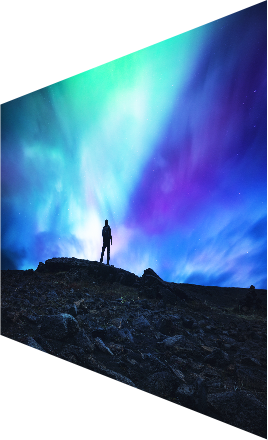[OLED] | SAMSUNG DISPLAY OLED ERA | The Offical Samsung Display Site
Samsung OLED
OLED
The image shows rectangular lights of four different sizes and colors and a light reflected beneath the light.
Unfold each panel to compare the structure of LCD and OLED. The left conventional LCD has the structure of Backlight, POL, TFT, Liquid Crystal, Color Filter, and Cover Window, and the Cover Window panel shows a blurred image. The OLED on the right has the structure of TFT, Self Emitting Organic Layer, ENCAP and Cover Window, and the Cover Window Layer shows an image with excellent color reproducibility.
Self-lit, simple, and slim.
No backlights, no complex color filters. Samsung OLED's organic materials emit brilliant light and color, all on their own. Eliminating the entire backlight configuration gives you an even thinner display. All with incomparably superior image quality.
Conventional
Others
-
1

-
2

-
3

-
4

-
5

-
6

-
1 Backlight
-
2 POL
-
3 TFT
-
4 Liquid Crystal
-
5 Color Filter
-
6 Cover Window
OLED
Organic Light Emitting Diode
-
1

-
2

-
3

-
4

-
1 Cover Window
-
2 ENCAP
-
3 Self Emitting Organic Layer
-
4 TFT
OLED panels are laid down horizontally. A flower is displayed clearly in vivid color in the black background. If you scroll down, a mark indicating the energy consumption rate moves at the bottom and through the mark, the consumption rate of Samsung OLED is reduced by about 40%.
Powerfully efficient pixels
Samsung OLED devices save you energy. Only individual pixels needed to express the image and colors are lit. Pixels in black sections stay completely unlit. By not covering light to simulate black, you save energy when plugged in and save battery power when on the go.
Power
Consuming
This is an image comparing LCD and OLED panels based on DCI-P3 (Digital Cinema International Standards). The game characters and the sky is shown and a panel frame is located in the center. OLED panel is shifted from LCD panel and a clearer color is displayed than when it was an LCD panel. At the bottom, the color reproducibility graph of the OLED increases 1.2 times compared to the LCD.
Dive into lush, vibrant color
Enjoy movies and games to the fullest. Experience the new standard used in digital cinemas around the world. A stunning 120% DCI-P3 displays a far wider color gamut. Movies feel closer to life. Games feel more intense. Imagery gets so vivid, it will take your breath away.
Conventional
X 1.2
color Volume
OLED




A girl is lying in a dark room and is watching a tablet PC. In the center of the image, you can see a text and graph stating, "Harmful Blue Lights less than 7.5%" In the upper right corner, Eye Care Display certification mark of Samsung OLED certified by SGS, a global certification institution, is located.
Eye care. Sleep care.
Blue light can cause visual discomfort and disrupt your sleep cycle. Certified as 'Eye Care display' by SGS, Samsung OLED reduces the wavelength of blue light without changing the color. Keep your eyes healthy and happy, and your circadian rhythm undisturbed—all with accurate color fidelity.



Harmful Blue Lightless than

Shows a video playlist of Samsung Display. In the video being played, there is a girl lying in a dark room and watching a tablet PC. When scrolled down, the screen gradually switches from light mode to dark mode, and at the same time, the battery usage time on the right increases. The usage time lasts 9 hours in light mode and 11 hours in dark mode.
Boost battery life with
Dark Mode
Get more from your battery with Dark Mode. A dark background makes content easier to see and read, plus keeps your eyes comfortable even in low ambient light. OLED dims dark pixels and completely turns off black pixels. So power consumption goes down, and the life of your display goes up.

Boost battery life with
Dark Mode
Get more from your battery with Dark Mode. A dark background makes content easier to see and read, plus keeps your eyes comfortable even in low ambient light. OLED dims dark pixels and completely turns off black pixels. So power consumption goes down, and the life of your display goes up.
















